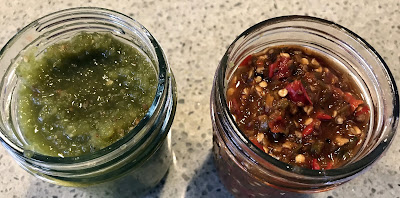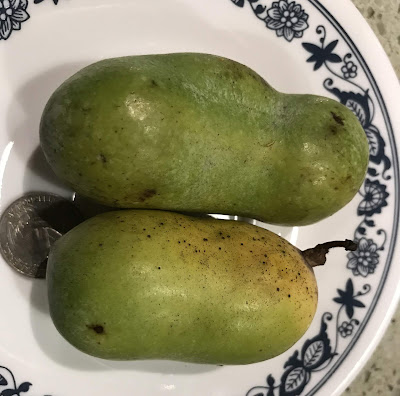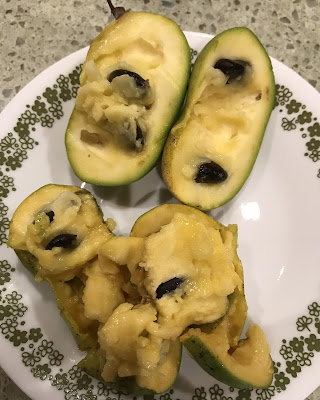 |
| Saijo Persimmon Tree. 10.28.15 |
This post has odds and ends from a few garden tasks, and walking around.
The
Asian type persimmons are closer to ripe. One of the Nikita's Gift persimmons was ripe. The
Saijo has about a dozen, not as large as last year, but then I didn't water it at all.
 |
| Columnar Apple Tree, Golden Sentinel, about 3 weeks after transplanting. 1-.28.18 |
The
columnar apple trees that I dug up, pruned, and t
ransplanted a few weeks ago (
10.6.18), are showing the stress. The larger one (
Golden Sentinel) has mosly brown leaves. However, a few remain green. Since it's fall and the other apple trees are starting to drop leaves, this is not necessarily a death sentence. There was more browning on The Golden Sentinel, than on the North Pole, which was smaller and younger, so lost less root mass relative to the top. Next Spring will tell.
Today I planted
one last row of garlic, from saved garlic heads. I don't know which variety, suspect German Red. I had to quit planting due to a back strain, and today was the soonest that I could. It's been raining. I hated to impact the wet soil, but it was either that or don't plant it. Meanwhile, the previous plantings are growing, some quite vigorously. The fastest seem to be
Spanish Roja. I planted those Oct 5th, so this frowth is 23 days post planting. There are some others, not shown, almost as large at 14 days, from saved cloves.
 |
| Garlic about 3 weeks after planting. |
 |
| Sets from Egyptian Walking Onions. 10.28.15 |
 |
| The Last of the Sunflower Pawpaws. 10.28.18 |
A gardener should listen to his body, and I did not. While moving minor stuff around 2 weeks ago, my back tweaked. Before fully better, I mowed and p
lanted some daffodils and more garlic, in heavy soil, and hauled some leaves. It worsened again. Now I"m being careful. No more heavy work until fully better, and I really do need to pay due diligence to back and other orthopedic health. Today, I planted the last of those garlic - intended and additional row, but wont.
Planted the rest of those daffodils. And cleared part of raised bed, which was pepper plants, and planted 6 rows of 10 sets each of
Egyptian Walking Onions. These were topsets that fell over during the summer, and are rooting in the rainy weather. The basal bulbs have about 6 inches of growth already, soon usable as scallions. Egyptian Walking Onions never fail to perform, even in bad weather and neglected.
The last of the
"Sunflower" Pawpaws fell off the tree. Nice sized fruits. So that's almost a month of Pawpaws. Very nice! The final fruits of the year, will be persimmons.
My conclusion about pawpaws: They really can be grown, and fruit, in the Pacific Northwest.
















































